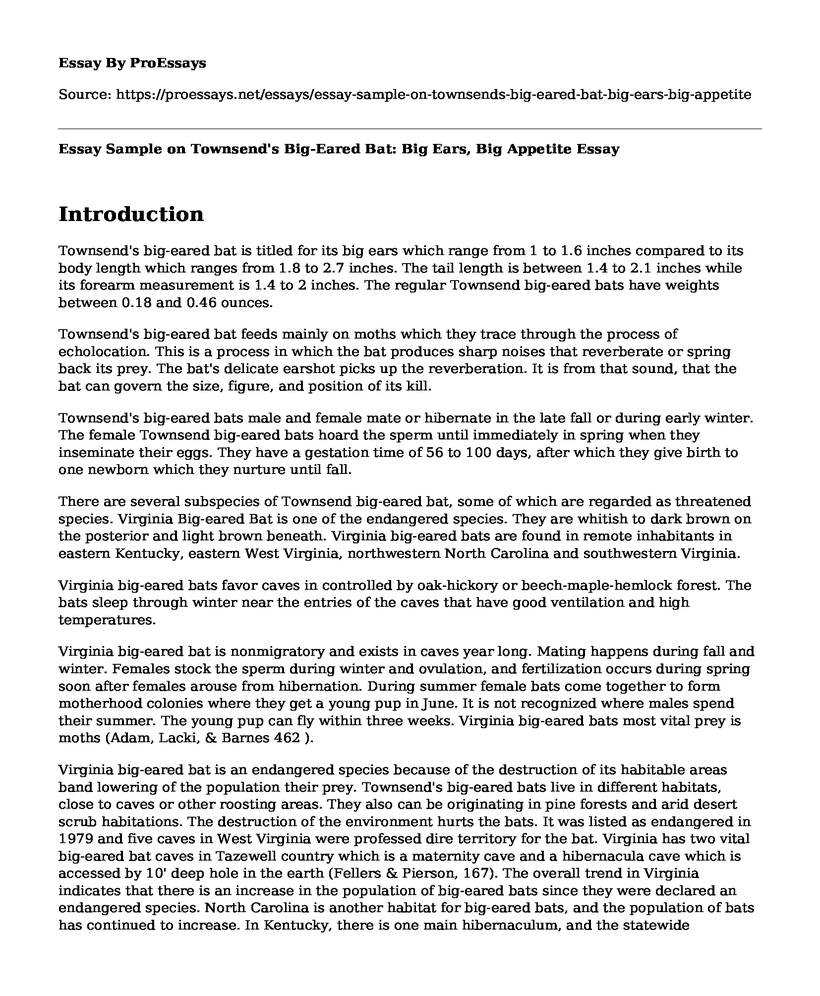Introduction
Townsend's big-eared bat is titled for its big ears which range from 1 to 1.6 inches compared to its body length which ranges from 1.8 to 2.7 inches. The tail length is between 1.4 to 2.1 inches while its forearm measurement is 1.4 to 2 inches. The regular Townsend big-eared bats have weights between 0.18 and 0.46 ounces.
Townsend's big-eared bat feeds mainly on moths which they trace through the process of echolocation. This is a process in which the bat produces sharp noises that reverberate or spring back its prey. The bat's delicate earshot picks up the reverberation. It is from that sound, that the bat can govern the size, figure, and position of its kill.
Townsend's big-eared bats male and female mate or hibernate in the late fall or during early winter. The female Townsend big-eared bats hoard the sperm until immediately in spring when they inseminate their eggs. They have a gestation time of 56 to 100 days, after which they give birth to one newborn which they nurture until fall.
There are several subspecies of Townsend big-eared bat, some of which are regarded as threatened species. Virginia Big-eared Bat is one of the endangered species. They are whitish to dark brown on the posterior and light brown beneath. Virginia big-eared bats are found in remote inhabitants in eastern Kentucky, eastern West Virginia, northwestern North Carolina and southwestern Virginia.
Virginia big-eared bats favor caves in controlled by oak-hickory or beech-maple-hemlock forest. The bats sleep through winter near the entries of the caves that have good ventilation and high temperatures.
Virginia big-eared bat is nonmigratory and exists in caves year long. Mating happens during fall and winter. Females stock the sperm during winter and ovulation, and fertilization occurs during spring soon after females arouse from hibernation. During summer female bats come together to form motherhood colonies where they get a young pup in June. It is not recognized where males spend their summer. The young pup can fly within three weeks. Virginia big-eared bats most vital prey is moths (Adam, Lacki, & Barnes 462 ).
Virginia big-eared bat is an endangered species because of the destruction of its habitable areas band lowering of the population their prey. Townsend's big-eared bats live in different habitats, close to caves or other roosting areas. They also can be originating in pine forests and arid desert scrub habitations. The destruction of the environment hurts the bats. It was listed as endangered in 1979 and five caves in West Virginia were professed dire territory for the bat. Virginia has two vital big-eared bat caves in Tazewell country which is a maternity cave and a hibernacula cave which is accessed by 10' deep hole in the earth (Fellers & Pierson, 167). The overall trend in Virginia indicates that there is an increase in the population of big-eared bats since they were declared an endangered species. North Carolina is another habitat for big-eared bats, and the population of bats has continued to increase. In Kentucky, there is one main hibernaculum, and the statewide population has continued to rise. In West Virginia, there are a total of ten big-eared bat caves.
Widening and increased traffic, road development and related projects have an effect of degrading the foraging and roosting habitats of the population which Increases the risk of big-eared bats becoming extinct. The main reasons of the species deterioration are the damage of habitat, augmented human examination to maternal roosts and hibernacula, contaminants, genetic isolation, disease, and vandalism. Virginia big-eared bats are tremendously sensitive to human interruption.
Even though Virginia big-eared bats are endangered, they have an advantage because they rely year-round on caves which decrease potential conflicts with forests managers and other human enterprises other than caving.
Works Cited
Adam, Michael D., Michael J. Lacki, and Thomas G. Barnes. "Foraging areas and habitat use of the Virginia big-eared bat in Kentucky." The Journal of wildlife management (1994): 462-469. 10.2307/3809317
Fellers, Gary M., and Elizabeth D. Pierson. "Habitat use and foraging behavior of Townsend's big-eared bat (Corynorhinus townsendii) in coastal California." Journal of mammalogy 83.1 (2002): 167-177. https://doi.org/10.1644/1545-1542(2002)083<0167:HUAFBO>2.0.CO;2
Cite this page
Essay Sample on Townsend's Big-Eared Bat: Big Ears, Big Appetite. (2023, Feb 15). Retrieved from https://proessays.net/essays/essay-sample-on-townsends-big-eared-bat-big-ears-big-appetite
If you are the original author of this essay and no longer wish to have it published on the ProEssays website, please click below to request its removal:
- Dow Corning Company Case Study Paper Example
- Should Genetically Modified Foods Be Labeled as Such?
- Paper Example on Veins and Arteries of the Body
- Paper Example on Investigating PDGFA-Driven Gliomagenesis: Impact on Malignant Glioblastomas
- Essay Sample on Exploring Eating in the Dark: Enhancing Other Senses
- Exploring The Wonders of the Ocean - Essay Sample
- Free Essay Sample on Natural Capital: Essential for Human Survival







